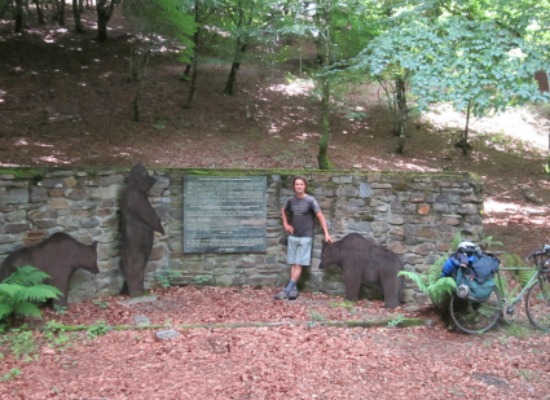Can Brown Bears Survive in the Pyrenees?
The keepers of sheep and cows helped eliminate the Pyrenean brown bear, and shepherds are not thrilled to see France’s largest predator return
/https://tf-cmsv2-smithsonianmag-media.s3.amazonaws.com/filer/20120612110029BearsBrownBearSMALL.jpg)
This is bear country—but just barely. The brown bear lived in the Pyrenees until 1991, when the last of the region’s bears is believed to have been killed. But a reintroduction program, launched in 1995, seeded the wild and remote Midi-Pyrenees with a handful of brown bears selected from Slovenia. Today 20-something of the animals—Ursus arctos, the same species as the North American grizzly bear—roam the mountain range. I pedaled deep into the mountains, up the lush Garrone River valley, almost all the way to Spain, to meet Jean-Michel Parde, a local biologist who worked on the reintroduction program in its early years and now lives in the village of Fos, just three miles from the site of the 1995 bear release. Parde believes 600 brown bears could inhabit the Pyrenees—if people would only let them.
But the Pyrenees are densely populated by sheep and cows—and it was the keepers of these animals, largely, who eliminated the Pyrenean brown bear in the first place. After decades of so much hard work to eradicate the last of France’s large predators, shepherds are not thrilled to see the bears on the way back.
In his living room, Parde told me that the bears, since their first summer back in the Pyrenees, have regularly attacked the local flocks. By some estimates, about 200 to 300 sheep are killed each year by the resident bears. Meanwhile, roughly 15,000 Pyrenean sheep die each year of other causes, including falls from cliffs and violent mountain storms. Dogs, too, take a toll that may run as high as 1,000 sheep a year. The French government compensates shepherds for the livestock killed by bears—and generously. A dead sheep can bring reimbursement of anywhere between 100 and 500 Euros, with each payment offering about 50 Euros more than the price of buying a new animal. For cows killed by the bears, reimbursement fees may go as high as 2,000 Euros.
But Parde, who keeps a few sheep of his own in the hills and has lost several to the bears, says success of the reimbursement program has been limited by the difficulty in proving that a bear has killed one’s sheep: providing the evidence, bringing the carcass to experts to analyze and convincing them it wasn’t dogs or lightning. He referred to an incident in 2008 when 28 sheep were killed both directly and indirectly when a number of sheep apparently fell off a cliff during the attack. The shepherd received compensation only for the animals bearing claw and tooth damage. Keeping shepherds happy as bears multiply in the mountains is proving to be the most difficult part of the reintroduction.
Parde took me back to the 1990s and laid out the story for me. The first bears were reintroduced in 1995 and 1996—first a pair of females, which biologists named Ziva and Melba, and a year later a male—Pyros, a large bear weighing nearly 700 pounds fresh out of hibernation. By 1996, both female bears had cubs. However, Melba was already habitually attacking sheep. So was Pyros, who showed little fear of people and was regularly spotted near villages. He has even ventured to within 30 miles of downtown Toulouse.
Melba was shot and killed after she charged a pig hunter. The young man, a neighbor of Parde at the time, had accidentally come between the bear and her cubs. She raced at him, probably just bluffing, but he shot to protect his life. Melba dropped dead; her cubs vanished into the mountains.
Ziva, the other female, adapted well. She would produce multiple generations of cubs while inflicting very little damage on the local sheep population. She spends much of her time in Spain.
“She was a convenient female for the program,” Parde says.
After a decade, biologists decided some new genetic material was needed in the bear population. So the French government went again to Slovenia, thickly populated with brown bears, for a new crop. But by then, in 2006, Italy had reintroduced bears to the Trentino region in the Dolomites and had had first pick of the most desirable (middle-aged, reproductively promising, healthy) animals from the same region that the French were now plying. Parde says that in a population of 100 bears, just 30 will be of breeding age. Of these, 15 will be females, and of these just seven or eight will be without cubs—thereby meeting requirements for relocation. After Italy’s removal of several animals, the split came out poorly for the French. Parde says the Pyrenean project, which aimed its reintroduction efforts this time at the wild Ariege region, received one old female that ate garbage and killed sheep for sport, outraging farmers until she was hit by a car and killed several years ago near Lourdes (to the delight of local sheep herders). Of the three other females, one was healthy and young and caused no problems with shepherds—but she fell off a cliff and died. Another was reliably reproductive, but she killed many sheep—producing new bears but generating antipathy against the population as a whole. The fourth female has inflicted minor damage on sheep flocks. She is still alive, spends most of her time in Spain but has never produced a cub.
“Perhaps cubs will arrive,” Parde said, “but so far she has been unsuccessful for demography.”

NON AUX OURS. While Andy Schleck, Lance Armstrong and other cyclists in the Tour de France are met with spray-painted messages of praise on the Pyrenees mountain highways, brown bears are not. This message, written in French on the road between two high Tour de France passes, means "NO TO THE BEARS." Photo by Alastair Bland.
There was a male bear in the second batch, too—and of eight bears released in total, between 1995 and 2006, just two have been productive female breeders. The population now numbers between 20 and 30, a number which French geographer and brown bear expert Farid Benhammou told me via email could be a sustainable one.
But Parde says he thinks most of the bears in the Pyrenees are a cousin and sibling group that will not be self-sustaining in the long run unless new genetic material is provided. The population, he thinks, will need more bears, but with 100,000 sheep in these mountains, opposition from shepherds is as strong as their cheese is profitable, and just whether more bears will be delivered is uncertain. Parde told me that there has been talk of cooperating with Spain, where an island population of about 100 bears in the northwest mountains is built of animals genetically and behaviorally similar to the extinct Pyrenean brown bears—but Spain has been uncooperative, Parde said, and at best might concede to letting France borrow some breeders for a while before giving them back.
While buying cheese one recent morning I asked the farmer how he felt about the bears. “We are very much opposed,” he said in English. Have the bears killed any of your sheep, I asked? “Not yet,” he said. Most farmers, I think I can guess, might share his sentiments—expressed largely through anti-bear slogans spray-painted on the highways.
When I left Parde’s home, I followed his directions and rode my bike high up a bumpy road into the forest above his village. There, in the damp broad-leaf woods, I found the monument honoring the bears of the first release. The site is not vandalized, without a dash of spray-paint, and near as I know, it was as close to a Pyrenean brown bear as I’ve been.

The author stands at a monument placed in the forest near the border of Spain at the site where three bears were released in 1995 and 1996. Photo by Alastair Bland
Just an hour later I encountered a sheep drive, with locals bringing their animals into the high country. It’s likely that these sheep, little may they know, will soon be attacked by a bear. I wished them a silent good luck, and the same to their shepherds—but better luck to the bears.
Planning Your Next Trip?
Explore great travel deals
Smithsonian magazine participates in affiliate link advertising programs. If you purchase an item through these links, we receive a commission.
/https://tf-cmsv2-smithsonianmag-media.s3.amazonaws.com/accounts/headshot/Off-Road-alastair-bland-240.jpg)
/https://tf-cmsv2-smithsonianmag-media.s3.amazonaws.com/accounts/headshot/Off-Road-alastair-bland-240.jpg)